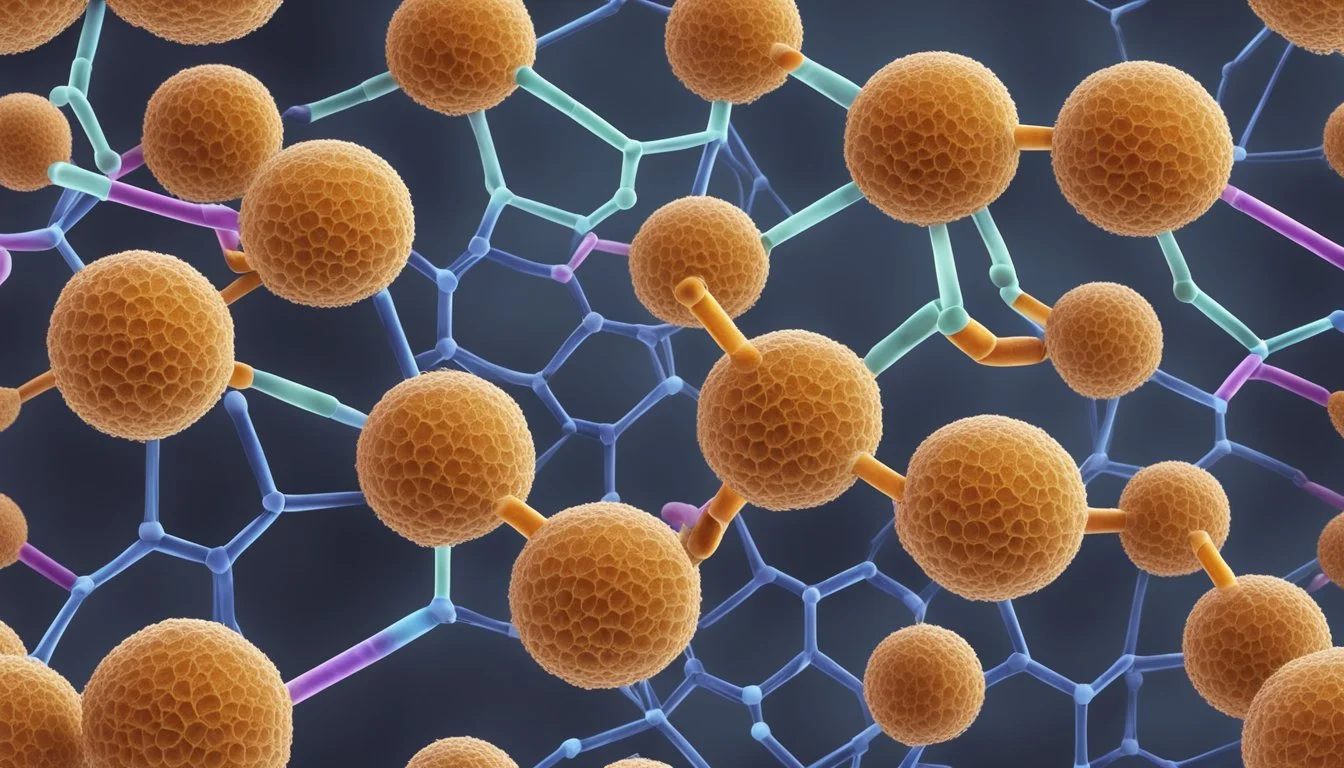The Anti-Diabetic Properties of Cinnamon
Exploring Its Blood Sugar Regulatory Benefits
Cinnamon, a common spice derived from the inner bark of several tree species from the genus Cinnamomum, is not only treasured for its flavor but also for its potential health benefits. Among these, the anti-diabetic properties of cinnamon have attracted scientific interest. Studies suggest that various types of cinnamon, including Ceylon and Cassia, might have a role in managing and preventing diabetes. The potential mechanisms behind these effects include improving insulin sensitivity, enhancing insulin secretion, and possibly mimicking insulin's actions.
The active components in cinnamon, such as polyphenolic polymers, could positively influence blood glucose control, a critical aspect in the management of diabetes. Furthermore, research indicates that cinnamon might inhibit the activity of enzymes like alpha-glucosidase and pancreatic amylase, which are involved in the digestion of starches, thereby reducing postprandial blood glucose levels. There is also evidence that cinnamon can act as an antioxidant, combatting oxidative stress, a common complication in diabetics.
Cinnamon Overview
Cinnamon, an ancient spice with widespread culinary and medicinal uses, is derived from the inner bark of trees within the Cinnamomum genus. This section delves into the plant's botanical characteristics and the diversity among species highlighting Cinnamomum cassia and Ceylon cinnamon, known scientifically as Cinnamomum zeylanicum.
Botanical Features
Cinnamon trees are evergreens that can reach heights of 10 to 15 meters. The oval-shaped leaves are leathery, with a dark green hue and a distinctive aromatic scent when crushed. Its bark, once dried, curls into rolls called cinnamon sticks. These trees bear small, white flowers during the blooming season, leading to the production of purple berries.
Cinnamomum Species
Cinnamomum cassia
Commonly known as Chinese cinnamon or cassia
Bark is thicker and coarser compared to other varieties
Contains higher levels of coumarin, a compound that can be harmful in large doses
Ceylon cinnamon (Cinnamomum zeylanicum)
Also referred to as true cinnamon or Sri Lankan cinnamon
Thinner, more delicate bark with a lighter color and sweeter taste
Considered to be of higher quality and possesses lower coumarin content
The different species of cinnamon are not only distinct in their physical attributes but also in their chemical constituents, which contribute to their unique flavors and health benefits.
Phytochemistry of Cinnamon
Cinnamon's notable health benefits can be largely attributed to its rich array of phytochemicals. These compounds are responsible for both the spice's distinct aroma and its potential anti-diabetic effects.
Key Bioactive Compounds
Cinnamon is replete with bioactive substances, with cinnamaldehyde being the most prominent compound that gives the spice its distinctive smell and flavor. Research attributes many of cinnamon's health properties, including its anti-diabetic effects, to this organic compound. Eugenol is another vital compound found in cinnamon, contributing not only to the aroma but also displaying anti-inflammatory properties. Cinnamon also contains coumarin, a compound with anti-coagulant properties; however, it's present in higher concentrations in Cassia cinnamon and can be harmful in large doses.
Cinnamic acid, another notable compound, is a precursor to cinnamaldehyde and an integral part of cinnamon's essential oil profile. This acid has been shown to possess antioxidant properties. Additionally, cinnamon is rich in procyanidins, which are polyphenolic compounds that may have an insulin-like effect on blood sugar control. The spice's essential oils collectively contribute to its therapeutic capabilities, which include, but are not limited to, its anti-diabetic benefits.
Nutritional Profile
Cinnamon is not only treasured for its potent bioactive compounds but also for its nutritional profile. Although typically consumed in small amounts, cinnamon offers a range of nutrients that play a role in overall health. A notable nutrient in cinnamon is dietary fiber, which can aid in digestive health. While the calorie content of cinnamon is minimal, the spice enhances flavor without the need for added sugars, making it a beneficial addition to a diabetic diet.
This nutritional complexity, paired with the key bioactive compounds like cinnamaldehyde and procyanidins, underpins cinnamon's therapeutic potential, particularly in the context of blood sugar regulation and diabetes management.
Cinnamon and Type 2 Diabetes
Recent studies have highlighted cinnamon's potential in managing blood glucose levels and improving insulin sensitivity, which are crucial concerns for individuals with type 2 diabetes mellitus.
Effects on Blood Glucose Level
Research indicates that cinnamon may reduce fasting blood glucose. Clinical trials have shown a decrease in hemoglobin A1c, which is a key indicator of long-term glucose control. By affecting glucose transporters like GLUT4, cinnamon can facilitate better glucose uptake in cells.
Influence on Insulin Sensitivity
Cinnamon has been shown to enhance insulin receptor activity and increase insulin sensitivity. This improvement helps to mitigate insulin resistance, which is a hallmark of type 2 diabetes. The bioactive compounds in cinnamon appear to modulate signaling pathways that activate insulin receptors, promoting glucose uptake.
Impact on Glucose Metabolism
Through its effect on enzymes involved in glucose metabolism, cinnamon can reduce starch digestibility, leading to lower post-meal glucose levels. It also supports glycogen synthesis, which is essential for energy storage and utilization, and may inhibit gluconeogenesis, the production of glucose from non-carbohydrate sources.
Mechanisms of Anti-Diabetic Action
Cinnamon has garnered attention in the scientific community due to its anti-diabetic properties, which have been shown to work through various biological pathways, significantly impacting glucose regulation.
Antioxidant Properties
Cinnamon's ability to enhance antioxidant defenses in the body is a primary mechanism through which it exerts anti-diabetic effects. Antioxidants in cinnamon help neutralize reactive oxygen species (ROS), which are implicated in the oxidative stress associated with diabetes. Researchers have observed a reduction in oxidative stress markers following cinnamon intake, suggesting the spice's role in bolstering antioxidant status.
Anti-Inflammatory Effects
Additionally, the anti-inflammatory qualities of cinnamon are vital. Inflammation is a known contributor to insulin resistance, and by mitigating this inflammation, cinnamon may help improve insulin sensitivity. Studies illustrate that cinnamon can reduce levels of pro-inflammatory molecules, thereby potentially diminishing the inflammation-related pathologies in diabetes.
Enhancing Insulin Signaling
Cinnamon has shown promise in enhancing insulin signaling pathways. This includes upregulating the translocation of glucose transporters to the cell membrane and enhancing the activity of peroxisome proliferator-activated receptor (PPAR), both crucial for maintaining normal glucose levels. Through these actions, cinnamon assists in the effective uptake of glucose into cells, directly contributing to its anti-diabetic effects.
Clinical Efficacy and Safety
Cinnamon has been studied in clinical trials for its potential role in managing diabetes mellitus, with a focus on how it affects blood glucose and lipid profiles. Understanding the outcomes of these studies and the safety profile of cinnamon is crucial for its consideration as a dietary supplement for diabetic patients.
Human Clinical Studies
Studies have indicated that cinnamon may exert beneficial effects on glycemic control in individuals with type 2 diabetes mellitus. Specifically, clinical trials have observed improvements in fasting blood glucose levels, glycated hemoglobin (HbA1c), and insulin sensitivity. Cinnamon has also shown potential in affecting lipid profiles, with some studies reporting reductions in total cholesterol, low-density lipoprotein (LDL) cholesterol, and triglycerides, as well as increases in high-density lipoprotein (HDL) cholesterol. It is important to note that these outcomes can vary depending on the type of cinnamon used and the dosage administered.
Key Outcomes in Clinical Trials:
Fasting Blood Glucose: Reductions have been observed, suggesting improved blood sugar management.
HbA1c: Decreases have been reported, indicating better long-term glucose control.
Lipid Profile: Some studies noted improved lipid profiles, with reductions in total cholesterol, LDL, and triglycerides, and increases in HDL.
Toxicity and Safe Dosage
The safety of cinnamon has been evaluated in various studies to ensure compliance with recommended dosages and to minimize toxicity. Cinnamon is generally considered safe when consumed in culinary amounts. However, the coumarin content in Cassia cinnamon, a common variety, has been a concern at higher dosages due to potential hepatotoxic effects. Safe dosages of cinnamon supplements typically depend on the type of cinnamon and the duration of the intake.
Guidance for Safe Consumption:
Culinary Use: Generally safe in amounts used for cooking and baking.
Cassia Cinnamon: Careful monitoring of intake is advised due to coumarin content.
Supplement Dosage: Adherence to recommended dosages from clinical trials or healthcare providers is necessary to avoid potential toxicity.
Randomized clinical trials conducted with strict adherence to dosage guidelines and study protocols provide valuable information on the anti-diabetic effects and safety of cinnamon, contributing to our understanding of its role in diabetes management.
Additional Health Benefits
Beyond its anti-diabetic properties, cinnamon exerts positive effects on various metabolic processes, notably in lipid metabolism, and offers protection against the complications often associated with diabetes.
Effects on Lipid Metabolism
Cinnamon has been shown to influence lipid metabolism, which is crucial for managing hyperglycemia—a standard concern in diabetic individuals. Studies suggest that regular consumption of cinnamon can lead to significant reductions in total cholesterol, LDL (bad) cholesterol, and triglycerides, with a slight increase in HDL (good) cholesterol. This modulation of lipid profiles denotes a beneficial role in cardiovascular health for those with diabetes.
Key points:
Reduction in total cholesterol: Notable decrease.
Lowering LDL cholesterol: Positive effect on bad cholesterol levels.
Decrease in triglycerides: Cinnamon contributes to lower triglyceride levels.
Increase in HDL cholesterol: Slight improvement in good cholesterol levels.
Protection Against Diabetic Complications
Diabetes can lead to chronic complications affecting multiple organ systems. The antioxidative properties of cinnamon enhance the body's antioxidant status, which can mitigate oxidative stress—one of the pathological mediators of diabetic complications. Regular ingestion of cinnamon is linked with improved protection against conditions such as diabetic neuropathy and nephropathy by safeguarding the tissues from damage caused by high blood sugar levels. Moreover, it can slow down gastric emptying, which may help in the better control of glucose levels after meals.
Specific impacts:
Enhanced antioxidant status: Bolsters defense against oxidative stress linked to diabetic complications.
Slower gastric emptying: May aid in postprandial blood sugar management.
Comparative Analysis
In examining the anti-diabetic properties of cinnamon, it's crucial to evaluate its efficacy in relation to other spices and in combination therapies.
Cinnamon Versus Other Spices
Cinnamon has been the subject of numerous studies due to its potential anti-diabetic effects, which primarily relate to its ability to modulate blood glucose levels. Fenugreek, another commonly used spice, has shown similar anti-diabetic potential. Here's a brief comparison of their properties:
Cinnamon:
Contains bioactive compounds which can increase insulin sensitivity.
May slow down carbohydrate digestion and glucose absorption.
Fenugreek:
Rich in soluble fiber, which can delay carbohydrate digestion and sugar absorption.
Contains compounds like fenugreekine which may contribute to its anti-diabetic effects.
Both spices have displayed glucose-lowering effects, but it's the compound composition that delineates their mechanisms of action. While the research supports the anti-diabetic properties of cinnamon, it's essential to note the variability among species and the need for more rigorous studies to establish clear clinical guidelines.
Cinnamon in Combination Therapies
Cinnamon's integration in combination therapies often aims to capitalize on its proposed synergistic effects when paired with other anti-diabetic agents. In clinical settings, cinnamon might be added to standard treatment regimens to potentiate the effects of conventional anti-diabetic drugs. Some studies suggest that when cinnamon is used alongside other treatments, it may help in reducing fasting blood glucose levels.
However, the efficacy of cinnamon as part of a combination therapy has produced mixed results and requires further investigation. It is hypothesized that different species of cinnamon may exhibit various levels of potency, leading to differing outcomes in studies. This underscores the necessity for individual assessments of cinnamon types in combination therapies to determine their true therapeutic potential.
Dietary Considerations and Usage
When considering the integration of cinnamon into a diet for its anti-diabetic effects, one should be informed about the appropriate methods of inclusion and potential synergy with other medicinal plants. Consistent and mindful inclusion into one's dietary routine can harness the potential benefits of cinnamon.
Incorporation into Diet
Cinnamon can be incorporated into a diabetic-friendly diet in various forms. One may sprinkle ground cinnamon on oatmeal or add it to smoothies, allowing for a flavorful and healthful addition. For baking, substituting a small portion of wheat flour with cinnamon can alter the glycemic index of baked goods. It is important to note that while cinnamon can contribute to glucose management, it should complement a balanced diet rich in magnesium and zinc, minerals that are vital for blood sugar regulation.
Methods to Incorporate Cinnamon:
Sprinkle ground cinnamon on breakfast cereals or yogurt.
Mix cinnamon into hot beverages like tea or coffee.
Use cinnamon in savory dishes like stews or curries.
Add cinnamon to smoothies for an enhanced flavor profile.
Synergy with Medicinal Plants
Cinnamon, when used in tandem with certain medicinal plants, may have enhanced benefits. For example, combining cinnamon with fenugreek, which has been associated with improved glucose tolerance, could amplify the anti-diabetic effects. However, it is crucial to consult a healthcare provider before combining with other diabetic treatments or supplements to ensure efficacy and safety.
Potential Synergistic Combinations:
Cinnamon and fenugreek
Cinnamon and ginger
Cinnamon and turmeric
In diet, balance and moderation are key. While cinnamon shows promise as an adjunct therapy for diabetes management, it is not a standalone treatment and should be part of a comprehensive approach to health.
Future Prospects
The ongoing research on cinnamon's anti-diabetic properties holds promising avenues for both understanding the mechanisms behind its effects and its use as a therapeutic agent. The development of cinnamon-based treatments for diabetes is moving toward more precise and evidence-based approaches.
Research Directions
Research to date indicates a significant interest in the enzymatic activity of cinnamon and its potential to regulate blood glucose levels. Ongoing studies are focusing on elucidating the specific compounds within cinnamon that may influence insulin release and the bioactivity of various cinnamon species. Scientists are also quantifying the effectiveness of cinnamon as a hypoglycemic agent, comparing it to existing medications.
Future studies are expected to investigate how cinnamon-derived products can be standardized and optimized for maximal therapeutic effect. They aim to provide clear dosage recommendations and identify any contraindications with current hypoglycemic agents. Further exploration into the poorly controlled type 2 diabetes subset is essential, as this group may benefit significantly from adjunctive natural therapies.
Potential Therapeutic Developments
Development of new therapeutic agents inspired by cinnamon is an exciting frontier in diabetes management. Research is steering towards isolating active ingredients that could be used to enhance or accompany current diabetes treatments. Preliminary trials suggest potential in using these natural compounds to stimulate insulin release and improve insulin sensitivity.
The prospect of integrating cinnamon or its extracts into diet modification plans for diabetic patients is also under consideration. The goal is to translate the findings from clinical studies into practical guidelines for the management of poorly controlled type 2 diabetes. Scientists are hopeful that with rigorous testing, cinnamon-based therapies might become a validated, natural complement to conventional diabetes treatments.
Conclusion
Research indicates that cinnamon possesses beneficial properties for managing hyperglycemia in type 2 diabetes. The most promising among different types is Ceylon cinnamon, which shows the best anti-hyperglycemic effects. It should be noted, however, that the efficacy of cinnamon can be species-specific, and hence, may vary.
Clinical studies have revealed a reduction in fasting blood glucose levels and glycosylated hemoglobin when cinnamon powder is administered for a duration of 12 weeks. Moreover, apart from its anti-diabetic properties, cinnamon has also demonstrated significant antioxidant, anti-inflammatory, and antibacterial activities.
It is important to acknowledge the need for long-term trials to ascertain the long-term efficacy and safety of cinnamon. While cinnamon holds promise as a complementary therapy, the current evidence is not yet conclusive. Medical professionals may consider the inclusion of cinnamon as an adjunct therapy in the integrative medical approach, but with careful monitoring and in appropriate doses.
Cinnamon's role in enhancing serum levels and reducing complications in individuals with poorly managed type 2 diabetes further supports its potential therapeutic benefits. With the ongoing investigation, confidence in cinnamon's anti-diabetic effects continues to grow, yet it is crucial to approach its usage with empirical evidence in mind.








